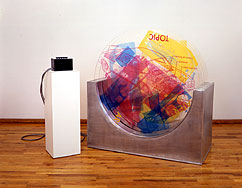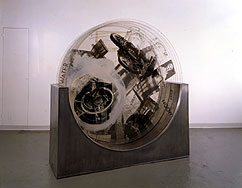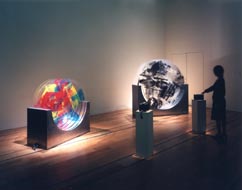 |
| Photo: Orcutt and Van Der Putten; (C) Robert Rauschenberg/VAGA, New York/SPDA, Tokyo |
 |
| Photo: David Heald(SRGM); © Robert Rauschenberg/VAGA, New York/SPDA, Tokyo |
 |
| Photo: TAKAYAMA Kozo |
|
|
In this series of works five switches allow the viewer to rotate five Plexiglas discs in either direction independently. The first three series used black silk-screened ink [images] and the last three introduced red, yellow, and blue. Through his participation in the theater works of John Cage and Merce Cunningham, Rauschenberg deepened his interest in technology, incorporating it into his own work to create interactive environments that would allow viewers to participate in his paintings and sculptures. This work gives viewers control over endless combinations of images. The kaleidoscopic transformations of images on the discs are reminiscent of the chance operations approach that Rauschenberg shares with John Cage. In Soundings and Solstice, the collaborative projects done in 1968 with engineers Billy Kl_ver and Fred Waldhauer, the switches that viewers were expected to use to control the works were hidden. In this respect, Rauschenberg's views on interactivity had taken one step closer to the concept of the "invisible environment." In 1992 the artist produced another mechanized revolving work on the theme of environmentally conscious energy systems. Eco-Echo V uses a sonar-activated motor and a bicycle wheel. It turns like a windmill when the sonar device detects the presence of objects or people in a circumscribed area. [KAMIKANDA Kei]
|
